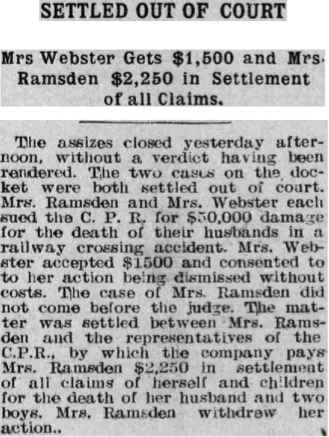Chapter
10: Mistakes Were Made...

On September 25, 1882, Dr. Fleming
submitted a bill to City Council for
$154, “for attendance on the Niblock lad, run over on the railway
track”. Thus with only a year having passed since the first
train,
“Young Niblock” became the first person in Brandon to be injured by a
train. P172 Kananagh
Trains can
be dangerous machines. Mishaps, derailments and collisions
are always a threat. Injuries are a way of life for railroaders.
Given the
enormous numbers of trains in motion this is to be expected,
but it is truly alarming to note that in 1899 in the US alone 1, 958
railway employees were killed in mishaps. 221 passengers killed in
accidents as well.
Railroading
was a dangerous job.
And for
the public, especially children, curiosity of trains and lack
of experience lead to a few tragedies.
Brandon’s
worst railway disaster happened in on Jan.13, 1916. It was
bitterly cold day and a group of temporary workers were taking a break
in the shelter of a caboose car of a snow clearing train. As the snow
train backed into the main line, preparing to shift to a new location,
another train hauling cattle slammed into it.
Of the
thirty workers taking shelter in the caboose, 17 were killed
instantly and one of the injured died afterwards.
Aside from
the snow train #39’s crew and a supervisor, the men working
on it were
Galacians
(from modern day Ukraine). They were desperate for work, and
took the job despite the cold and potential danger.
A
coroner’s jury blamed the railway for negligence but both crews
claimed they had the right of way.
Railway
authorities gave generous assistance to the families involved
and this and other incidents helped raise awareness and prompt calls
for better safety.
It was
nearly 23 years before another major accident occured. In the
early morning hours of August 28, 1939 three freight cars came loose by
the Mcabe elevator on 13th & slowly began to build up speed going
downhill toward the old cigar factory which was then the Codville
warehouse on 11th. Building up speed, it jumped the stops and crashed
into the building entrance. Luckily there were no injuries but had it
occured later, during business hours there most certainly would have
been injuries if not deaths.
There were
many more injuries than deaths, and many not officially
recorded. There are stories of railway men loosing limbs to mishaps by
cjumping on the moving trains something they commonly did. It was just
part of their job.
When
injuries did occur it was common of the brotherhood of railroaders
to offer assistance to the injured railroader family. At a time when
there was no medicare or welfare, this kept a railwayman’s family in
good care until they recovered.
The
"company" also tended o show loyalty to railmen as well. Once
a
victim was recovered and capable he was welcomed back to the yard in an
appropriate capacity.
There many tasks available in the
yard, such as switching or being in
the switch tower.
While we
may wince when reminded that the switch tower was was
nicknamed the "cripple house" the intentions were good – the men were
still employed - still had opportunity to feed their families.
Of course
there were also incidents involving other modes of
transportation.
Richard
Ramsden, his two sons and Charles Webster were killed by a
speeding train at the 6th street level crossing in 1900. A coroner’s
jury recommended that an overhead crossing replace both the 6th street
and 13th street crossings. The CPR negotiated a $2500 settlement with
Mrs. Ramsden.
This
incident and others likely prompted the CPR to finance a new
crossing at 8th Street in 1904.
 Brandon
Daily Sun, March 29, 1900 (Page 1)
Brandon
Daily Sun, March 29, 1900 (Page 1)
|


